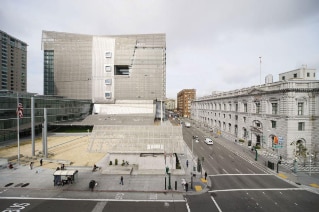Revolutions are always a threat to memory. The idea of being liberated from the "yoke of power" is tied to the process of canceling the signs through which that power reached its apex. Just think of the end of the various "museums of the revolution," for example, in Hungary and that a proposal was made for the demolition of Lenin's mausoleum and the relocation of those famous remains in Moscow's Red Square. In this sense, the current Arab "spring" may even put segments of these countries' historical heritages at risk.
Libya's history, for better or for worse, is inextricably linked to Italy, which, besides having very convincingly played the part of enforcer and executioner in the first phase of occupation, later undertook remarkable, powerful and comprehensive investments in constructing what was then known as Italy's "Fourth Shore," underlining the importance of a unifying Mediterranean basin. While the other Italian colonies were largely left undeveloped, Libya was annexed in 1938 and declared Italy's 19th Region.
From 1911 to 1920, the Italians, as Del Boca [1] has explained on several occasions, were involved, above all, in a bloody military crackdown implemented with the help of chemical weapons, while, from the 1920s onwards, they were committed to the construction of structures that would be useful to the community. In fact, architecture and the visual arts had already recorded a significant advance in the early 20s, especially in terms of building and urban planning. Armando Brasini, Alessandro Limongelli, Florestano Di Fausto, Alberto Alpago Novello, Ottavio Cabiati and Marcello Piacentini [2], among others, all went to Libya to design and build. But it was in the 1930s, especially under the governorship of Italo Balbo, that Libya saw a true influx of artists and public works [3]. In the second half of the 30s, construction sites throughout the Libyan territory were innumerable. Among them was the construction of Rural Villages [4] designed completely and "finished" with extreme care down to decoration and furniture designed by architects [5], painters, sculptors and Italian craftsmen who created styles suited to purpose and context. A distinctive "metaphysical" vernacular feature united most of the buildings, the omnipresent elongated portico that emphasized the perspective of the sequence of its white arches.
Funi, Ghiringhelli, and Melis—who directed the arts and crafts school in Tripoli, along with Prini, Quaglino, Reggiani and Selva—were among the many painters and sculptors who enriched the fabric of the Libyan aesthetic experiences through a variety of styles, making available their talents and going on site to help create Libya's new face.
Even if the Italian contribution to national the image of Libya has long been the subject of a form of damnatio memoriae [6]—something for the Italians to remove because it is inextricably linked to the fascist regime and its populist spectacle—for Libyans it is also an unwelcome topic insofar as it was the product of colonization that stifled national resistance. On Libyan soil, common and obvious signs of Italian occupation—still in operation today—remain functional to the life of its people. For example, the Governor's Mansion [7] in Tripoli still houses ministerial offices while the Cathedral was transformed in 1969, into a mosque by the mere removal of the crosses, altars, and the statue of the Pietà by Attilio Selva. The first excavations and restorations bringing to light the archaeological heritage of Sabratha and Leptis Magna [8], unique international tourist destinations, were the work of Italians.
The specific list would be very long, but it is important here to note that the appearance of the country's main cities, Tripoli and Benghazi, and even the most characteristic urban features of many of the smaller towns can been traced to Italian projects [9], but it is also exciting to discover that many signs of that presence are scattered throughout the Libyan territory.
I remember my amazement, during a visit to Tripoli during the second half of the 1990s, when I saw for the first time a bas-relief panel depicting a mounted knight fighting a dragon on the southern bastion of the Castle of Tripoli [10], overlooking the city's principal public space, Green Square. Anyone with any basic iconographic knowledge would immediately recognize Saint George. But how could it have ended up there? One day I discovered that this bas-relief was the work of the Genovese sculptor Prini and that it was a gift of Genoa to Tripoli as a sign of the twinning agreement between the two cities.
During my stay in Tripoli to further my research, which took place during the embargo, I was surprised to find all that I did. The climate of embargoed Tripoli ensured that a state spy followed me, controlling my every move. At the time, the archaeological museum, housed in the Tripoli Castle, only had captions in Arabic and the figure supervising the monuments was shadowed by someone who spoke only Arabic (and spit on the carpet of his office while he spoke with me with help of a translator). But, on the other hand, I remember the director of the Center for the Study of the Libyan Resistance as an educated and enlightened person who opened the precious archives of the Institute to me.
Tripoli, in particular, is currently still totally controlled by the Colonel—even if intent to solve daily issues of public policy, Benghazi, now a stronghold of the insurgents, and the whole area are all replete with visible signs of its heritage: the Gazelle fountain on Tripoli's waterfront, which is almost the primary symbol of the city, the Propylaea, structures midway between the flagpole and the obelisk, that stand out against the sky rising up from Green Square the same way they watch over Piazza San Marco in Venice, as well as several architectural works, buildings housing a variety of uses, including hotels such as the Uaddan and the Mehari, banks, schools, the buildings of the still-functioning fairgrounds. Many churches, now used for other functions, are distributed throughout the area (today they are often used as garages and warehouses) along with the roadworkers' houses located about every 50 km along the coastal road connecting Tripoli to Benghazi, and several hotels including the Hotel des Gazelles in Zliten, by architect Umberto Di Segni (1936),a dazzling example of rationalism "contaminated" by soft, oriental and Mediterranean lines and motifs, summarizing the design principles that so many theorists insisted upon at the time.
The war for the conquest of Libya goes back to 1911. Nearly three decades of domination resulted in significant investments of energy and material to undertake numerous initiatives in the country, which helped to shape the Italian collective imagination of the 20 years of Fascist regime and which represents a sampling of the taste and style trends of the time. Artists encountered the new territory by applying styles that refer in part to a more general exotic taste, but more often face the specific Libyan context, regarding both materials as well as styles, providing interpretations that are not at all banal. Among the "jewels" that are still intact, we find Funi's fresco cycle, in pure Giotto-esque style, in the church of San Francesco in Tripoli, the only place, after the 1969 revolution, dedicated to Catholic worship housing the seat of the bishopric. An interesting fact: we can make out the portraits of intellectuals from Balbo to Quilici to Brunelli in the likenesses of the monks.
What will remain of all this if Gaddafi completes his job? Unfortunately, his methods are now universally known. I remember a particularly sad story, whose veracity I was never able to verify, but, like all "urban legends," it says something that belongs to the collective imagination.
The story regards the destruction of a building, completed in 1915 as the headquarters of the Bank of Italy, overlooking Green Square in Tripoli. One of Gaddafi's government ministers whose name I can't remember, was restoring the building for his ministry, but the Colonel, who wanted to affirm the bedouin roots of Libyan culture and who was averse to permanent settlements, especially buildings that were examples of colonial architecture, preferred the government to have "nomadic" quarters. He held his meetings in tents in the desert between Tripoli and Benghazi in the hinterland of the Gulf of Sirte. To show his displeasure, Gaddafi ordered the building's demolition; one fine morning the city woke up to find yet another wound in its historic center, whose identity remains very legibly characterized by Italian public works. As for the Marble Arch—built to a design by Fausto Florestano on the border between Tripolitania and Cyrenaica along the coastal road from Tripoli to Benghazi, which, after the death of Italo Balbo, was named via Balbia—at the time of my trip, it was still standing, but today it is said that it was destroyed on Gaddafi's orders, but this is not the first time that this news has been reported.
Let's hope that Tripoli and Benghazi do not suffer the wounds of Beirut and that the bombing by the British in 1941–42 was the last. What remains in Libya has survived simply because there was no will to destroy it. But preservation does not mean merely not demolishing, but rather, restoring, reinterpreting, modernizing. From this point of view, France is a beacon but, unfortunately, its example, demonstrating the courage to change along with the responsibility of preserving, is a far cry for most countries.
A radio broadcast a few days ago informed us of the fact that it that it seems that Gaddafi has already contacted a team of plastic surgeons to change his features: everything changes.
And Italy?
[1] A. Del Boca, Gli italiani in Libia: dal facismo a Gheddafi, Rome 1988.
[2] Piacentini did many different projects, mainly in Benghazi, including the railway station, the Grande Albergo Italy and the Berenice movie theater.
[3] Lucio Scardino, "L'Officina ferrarese in Libia: Funi e gli altri," in Architettura italiana d'oltremare 1870–1940, Venice 1993.
[4] The villages, Bianchi (1937), Bede Littoria, Breviglieri, Gioda and Giordani (1938), were entirely designed by Di Segni, who, along with Pellegrini (architect of the Baracca village) also designed the Crispi (1938) and Tazzoli (1939) villages. Oliveti (1936) and Battisti (1938) are by Di Fausto. Their typology is similar to that of the new Italian "foundation" cities, with some variations in the lines.
[5] We recall the colonial house shown at the V Triennale in Milan by Luigi Piccinato.
[6] This "dual repression," among other things, has meant that the author has not yet found a publisher willing to publish the volume Arte italiana in Libia 1922–1942. Many architectural publications have been published over the past two decades regarding the typologies of Italian colonial architecture. Among them: Metafisica costruita. Le città di fondazione degli anni Trenta, dall'Italia all'Oltremare, exhibit catalog, Rome, April 8, 2002–May 30, 2002; Gresleri Giuliano, Pier Giorgio Massaretti, It Architettura italiana d'Oltremare, Bononia University Press, Bologna 2008. A special monograph on Umberto Di Segni, who worked extensively in Lbya, is authored by Jack Arbib (L'ombra e la luce. Note su Umberto Di Segni, architetto, Il laboratorio, Nola di Napoli 2010).
[7] Built between 1927 and 1930 and designed by Mantegazza-Meraviglia.
[8] Italian technicians made important archaeological discoveries, carrying out their restoration and overseeing the creation and exhibition design of the adjoining museums. See the models, made during the 1930s, of the archaeological sites preserved in the SIAO (Istituto Italiano per l'Africa Orientale-Italian Institute for East Africa) in Rome which acquired the materials of the Colonial Museum in Rome.
[9] The first of the Building Regulations for the city of Tripoli date from 1924; in the early 30s a new city plan followed.
[10] The architect Brasinine oversaw the restoration.
[11] Above the urban design projects, Di Fausto placed two bronze sculptures, a caravel and a gazelle. During the 1970s, the caravel was replaced with the figure of Omar Mukhtar, hero of Libyan resistance.
Elizabeth Longari is an art historian and critic who teaches contemporary art history at the Academy of Brera in Milan. She has published with several publishing houses (Electa, Mazzotta, Franco Maria Ricci, Silvana, Ilisso). Her work includes studies of Chighine Alfredo (1991) and Sironi and the V Triennale of Milan (2005). She has lectured at the University of Bellas Artes in Valencia, at the Sorbonne and Paris 8 in Paris. She has curated several exhibits, among which Jose Barrias at the Gulbenkian Foundation in Lisbon. She is vice-director of Academy of Fine Arts and has worked at Artforum.







